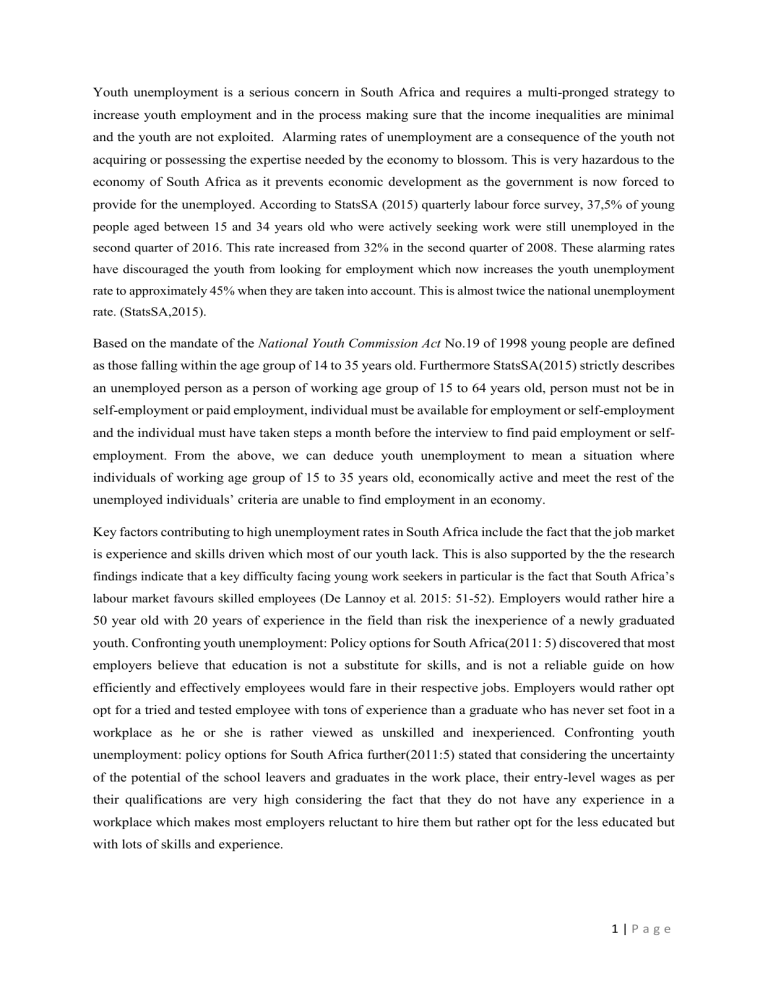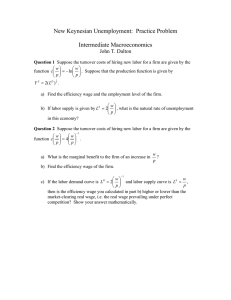Youth Unemployment in South Africa: Causes and Policy Impacts
advertisement

Youth unemployment is a serious concern in South Africa and requires a multi-pronged strategy to increase youth employment and in the process making sure that the income inequalities are minimal and the youth are not exploited. Alarming rates of unemployment are a consequence of the youth not acquiring or possessing the expertise needed by the economy to blossom. This is very hazardous to the economy of South Africa as it prevents economic development as the government is now forced to provide for the unemployed. According to StatsSA (2015) quarterly labour force survey, 37,5% of young people aged between 15 and 34 years old who were actively seeking work were still unemployed in the second quarter of 2016. This rate increased from 32% in the second quarter of 2008. These alarming rates have discouraged the youth from looking for employment which now increases the youth unemployment rate to approximately 45% when they are taken into account. This is almost twice the national unemployment rate. (StatsSA,2015). Based on the mandate of the National Youth Commission Act No.19 of 1998 young people are defined as those falling within the age group of 14 to 35 years old. Furthermore StatsSA(2015) strictly describes an unemployed person as a person of working age group of 15 to 64 years old, person must not be in self-employment or paid employment, individual must be available for employment or self-employment and the individual must have taken steps a month before the interview to find paid employment or selfemployment. From the above, we can deduce youth unemployment to mean a situation where individuals of working age group of 15 to 35 years old, economically active and meet the rest of the unemployed individuals’ criteria are unable to find employment in an economy. Key factors contributing to high unemployment rates in South Africa include the fact that the job market is experience and skills driven which most of our youth lack. This is also supported by the the research findings indicate that a key difficulty facing young work seekers in particular is the fact that South Africa’s labour market favours skilled employees (De Lannoy et al. 2015: 51-52). Employers would rather hire a 50 year old with 20 years of experience in the field than risk the inexperience of a newly graduated youth. Confronting youth unemployment: Policy options for South Africa(2011: 5) discovered that most employers believe that education is not a substitute for skills, and is not a reliable guide on how efficiently and effectively employees would fare in their respective jobs. Employers would rather opt opt for a tried and tested employee with tons of experience than a graduate who has never set foot in a workplace as he or she is rather viewed as unskilled and inexperienced. Confronting youth unemployment: policy options for South Africa further(2011:5) stated that considering the uncertainty of the potential of the school leavers and graduates in the work place, their entry-level wages as per their qualifications are very high considering the fact that they do not have any experience in a workplace which makes most employers reluctant to hire them but rather opt for the less educated but with lots of skills and experience. 1|Page In the early 2000s , South Africa’s economic policy moved from a labour-intensive agriculture economy to a high productivity and technology driven economy which has resulted in an increase in demand and absorption for highly skilled employees into the labour market. This proved to be a disadvantage to most of the youth as only a few of them had access to high-quality education. (Van der Berg et al. 2011) With a lot inequalities in the education sector in South Africa, it has become really difficult to obtain quality education as only a few can afford it, the poorer which constitute a larger proportion of the population end up dropping out of schools and in the process contributing to youth unemployment. The youth living in rural areas are also mostly disadvantaged as they have very little access to the labour market and information as compared to those in urban areas, which reduces their chances of finding employment. Racial inequalities also continue to play a role in the alarming rates of youth unemployment in South Africa. African and coloured youth are prone to find themselves unemployed as compared to their Indian or white counterparts (bbqonline, 2014) . StatsSA (2015) discovered that just over 40% of African Youth and 32% of the coloured youth are unemployed compared to 23% of Indian and 11% of the white youth. One major reason why the young white youth have better employment opportunities is because they poses most of the employment-enhancing features such as high quality education, better family background and their accessibility to the labour market. Mlatsheni and Rospabé (2002:16) further discussed that these differences are a consequence of the Apartheid era where the black people were prevented from accessing high quality education which was reserved for the white people. As a result through quality education white people were able to access better employment opportunities and pave way for their young ones whilst the blacks were left segregated. “Furthermore, the policies of “influx control” and “Homelands” have hindered the mobility of Africans and constrained them to live in areas with low employment opportunities.” . (Mlatsheni & Rospabé , 2002:16) This geographical barrier has denied the African youth access to the labour market. Despite the fact that the African youth have better labour market participation rates as compared to their coloured or Indian counterparts StatsSA (2015) revealed that for one employed black graduate there were five employed white graduates and four Indians. Irrespective of the education levels, the African youth absorption rates into the labour market remained low. Even after holding educational attainment and literacy and numeracy test scores constant the study revealed that the coloured youth start out with higher wages as compared to the African youth. These significant differences could be explained by the initial disadvantage experienced by the African youth in the Apartheid era. Network effects that the coloured youth possessed proved to be one of the main reasons why the coloured youth obtained better paying jobs on the outset (Leibbrandt & Mlatsheni, 2015:29). Due to the fact that the African youth lack or have little employment-enhancing features such as better networks and good family 2|Page backgrounds and they stay for longer durations with no employment opportunities, they tend to settle for lower reservation wages as compared to the white or coloured youth. Sangonet (2014) stated that South Africa is considered to be one of the most unequal countries in the world along with countries like Namibia and Seychelles with higher Gini Coefficients used to measure income distributions. Most of the country’s wealth is concentrated in the hands of the white and coloured minority which puts the African youth at a disadvantage of finding better paying jobs. On the 1st of January 2019, the minimum wage came into effect. The minimum wage is the active labour market policy that sets the minimum remuneration that employer is required to pay the employees in a given period and cannot be negotiated. This wage is set by the government of South Africa. This is important because it protects the workers from exploitation by employers, reduces income inequality and helps the employees to be able to meet the living wage. The minimum wage impacts can be summarised using the labour market model. When it comes into effect, the assumption are that as wages are raised through the introduction of the minimum wage, it will reduce the firm’s profits and in the process cause the firm to close down or retrench workers thereby increasing the youth unemployment. The impact of the minimum wage on youth unemployment is summarised below. 3|Page Figure 1: Showing the labour market model with respect to different wage levels. Average Product of Labour Real Wage (R) i ii iii Price Setting Curve B A 1 Employment,N C 2 3 KEY (i) Minimum wage setting curve (ii) Wage setting curve (iii) Minimum wage setting curve with higher effort levels We see that the wage setting curve with the minimum wage lies above the wage setting with no minimum wage in effect. This is a shift of the of the wage setting curve to the left (from point B to A). Looking at the intersection of the wage setting curve with the minimum wage in effect, we realise that 4|Page the real wage is unaffected but unemployment has increased since the level of employment is lower. So the minimum wage affects the workers negatively since now most of them are unemployed. However this theory does not hold in reality. In reality we see that the wage setting curve with the minimum wage lies below the wage setting curve with no minimum wage in effect. This is a shift of the wage setting curve to the right (from point B to C). As minimum wage comes into effect which increase the workers’ wages, their employment rent increases. This now means that workers now value their jobs more as the opportunity cost of being unemployed has increased, so they exert more effort at work which increases the firm’s profits and outputs. As a result, the workers do not lose their jobs but instead the firm hires more workers which reduces youth unemployment. This is true in developing and developed countries like Brazil, China and Russia who have incorporated this strategy and their unemployment rates have fallen ever since. This claim is supported by the evidence from Trading Economics (2019) that the unemployment rate in Brazil fell from 12.5 percent to 11.8% in three months as a consequence of the minimum wage. Reducing youth unemployment can only be achieved through both short-term and long-term strategies that equip the youth with better education and expertise, increase the demand for labour, and empower the African youth through labour market interventions which review the labour market policies. The introduction of the minimum wage is a step in the right direction towards achieving that and reducing income inequalities in South Africa. 5|Page BIBLIOGRAPHY Africa, S. (2019). 2015 | Statistics South Africa. [online] Statssa.gov.za. Available at: http://www.statssa.gov.za/?m=2015 [Accessed 20 Sep. 2019] A focus on youth: An opportunity to interrupt the intergenerational transmission of poverty. 2015. Cape Town: The South African Child Gauge. Brazil Unemployment Rate | 2019 | Data | Chart | Calendar | Forecast | News. 2019. Available: https://tradingeconomics.com/brazil/unemployment-rate [2019 , September 20]. De Lannoy, A., Leibbrandt, M. & Frame, E. 2015. A focus on youth: An opportunity to interrupt the intergenerational transmission of poverty. Available: https://sites.google.com/site/lannoyariane/booksand-book-chapters [2019 , September 20]. Inequality in South Africa. 2014. Available: http://www.ngopulse.org/article/inequality-south-africa [2019 , September 20]. CRISES, Y. 2014. YOUTH UNEMPLOYMENT CRISES. Available: http://www.bbqonline.co.za/articles/youth-unemployment-crises-24244.html [2019 , September 20]. Mlatsheni, C. & Rospabé, S. 2002. Why is Youth Unemployment so High and Unequally spread in South Africa?. Available: http://www.humanities.uct.ac.za/sites/default/files/image_tool/images/36/DPRU%20WP02-065.pdf [2019 , September 20]. Mlatsheni, C. & Leibbrandt, M. 2015. An Analysis of the First Wage of Youth in Cape Town. Available: http://2015.essa.org.za/fullpaper/essa_2871.pdf [2019 , September 20]. National Treasury(South Africa). 2011. Available: http://www.treasury.gov.za/documents/national%20budget/2011/confronting%20youth%20unemploy ment%20-%20policy%20options.pdf [2019 , September 19]. NO. 19 OF 1996: NATIONAL YOUTH COMMISSION ACT, 1996.. 2019. Available: https://www.gov.za/sites/default/files/gcis_document/201409/a19-96.pdf [2019 , September 20]. 6|Page




